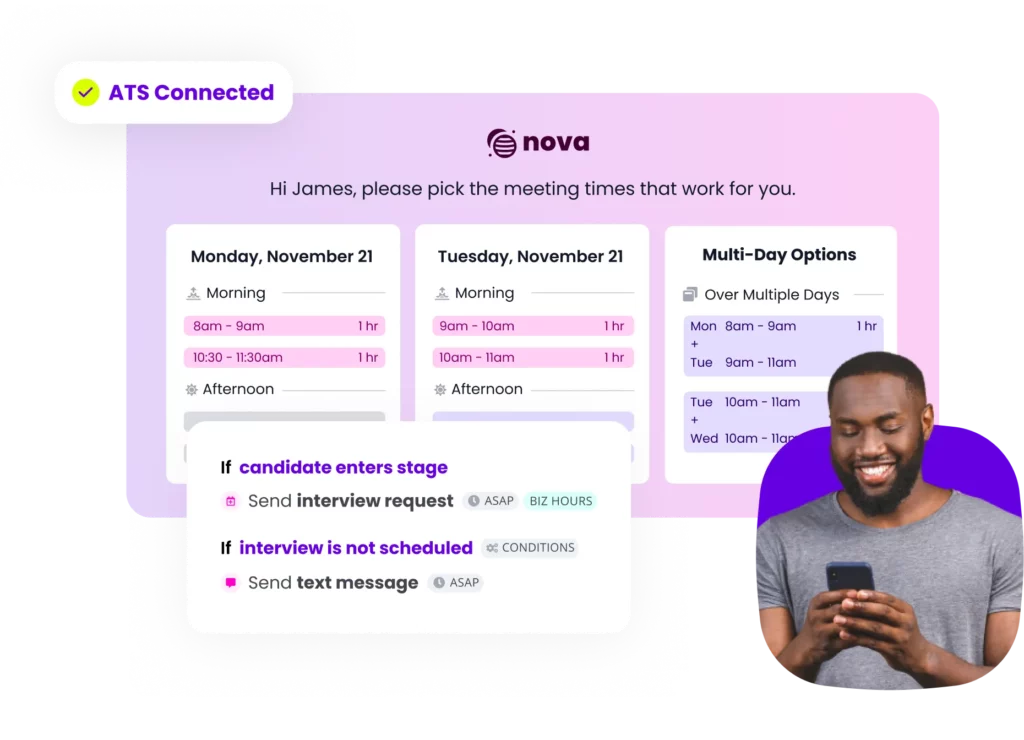Table of Contents
Diversity and inclusion in the hiring process are widely discussed topics in talent acquisition communities—and for good reason. Both are critical in creating a healthy environment, full of a range of perspectives, where employees feel comfortable being their true selves. If your hiring team isn’t prioritizing diversity and inclusivity, you’re doing something wrong.
DE&I is undoubtedly crucial for every hiring strategy, with diverse companies outperforming other companies by 33%. And as 70% of candidates say that a company’s D&I efforts are significant when job hunting, it’s clear that D&I is top of mind for both hiring teams and job seekers.
But far too often in conversations, the lines between diversity and inclusion are blurred, almost as if they’re one and the same. Yet this couldn’t be farther from the truth. Diversity needs inclusion and inclusion needs diversity to create a holistically enjoyable and equitable workplace.
So, what’s the difference between the two? And how should talent teams promote both?

Unlock 2025’s top hiring strategies: Insights from 500+ TA leaders
Be the first to uncover deep hiring insights specific to your sector — straight from the highest-performing TA teams.

DEI hiring: Understanding diversity, equity, and inclusion
A diverse company is a company that hires a wide range of individuals. This workplace promotes diversity across characteristics including race, age, ethnicity, gender, sexual orientation, disability, religious beliefs, education, and more.
Equity in the workplace refers to ensuring fair treatment, access, and opportunity for all employees. While diversity focuses on the presence of varied characteristics in the workforce, equity emphasizes the importance of ensuring that every individual has an equal chance to succeed, irrespective of their background or characteristics. This may involve adjusting resources or support to compensate for systemic biases or disadvantages that exist.
An inclusive company is a company that ensures all individuals, regardless of their background or characteristics, feel welcome. This workplace celebrates differences for the significant value that they bring to the workplace.
The benefits of DEI in the workplace are immense. Now that we’ve differentiated between the two terms, how can you facilitate both in your recruiting?
How are companies prioritizing diversity hiring?
In last year’s Hiring Insights report, we shared that 28% of companies planned to make DEI hiring a measurable priority in 2023, but this year’s report shows that only 24% followed through on that goal. Overall, the number of companies prioritizing diversity and inclusion in hiring has fallen two years in a row now.
What’s even more concerning is that DEI is likely to be deprioritized further, with only 24% saying it’s a focus area for 2024.
While you would be hard-pressed to find a TA leader who thinks DE&I isn’t important, the reality is that many are failing to prioritize it against all the pressures they’ve faced in the last few years. But it’s worth it to carve out the time and resources needed to build a diverse and equitable organization — not just because it’s the right thing to do, but because 78% of the workforce says it’s important to them.
Boosting diversity and inclusion in your hiring practices
Creating a positive experience for candidates should always be at the forefront of your mind. It’s part of why diversity and inclusion are both so important: an environment that isn’t accepting of some people is unacceptable for all people.
Don’t just take our word on the benefits of a truly diverse and inclusive hiring process. We spoke with Mawulom Nenonene, a seasoned expert and Head of Talent at LTSE about the topic. You can watch the full webinar below or keep reading for our key insights.
Building a Foundation for Equity: LTSE integrates diversity, equity, and inclusion (DEI) principles into talent acquisition by utilizing pipeline data for strategic top-of-funnel sourcing planning. This approach promotes consistency and reduces biased hiring.
Templates for Success: Role templates at LTSE serve as a central source for hiring managers to find the best candidates. These templates go beyond simple job descriptions, involving additional discovery to understand role goals and required expertise. This emphasis on role understanding is as vital as formal education requirements.
Promoting the Importance of Diversity: The article highlights the significance of diversity for organizational success. Gartner research indicates that organizations with diverse and inclusive decision-making teams are more likely to surpass financial targets. Gender-diverse and inclusive teams outperform homogeneous ones by 50%, and millennials show higher engagement in inclusive company cultures.
Crafting Skills-Based Job Descriptions: Hiring managers should focus on clear, actionable steps for skills-based hiring, ensuring inclusive language and minimizing bias in job descriptions.
The Rooney Rule and the Mo-rule: The Rooney Rule, requiring consideration of underrepresented candidates, is adapted at LTSE to include interviewing multiple women and underrepresented candidates before extending an offer. The Mo-rule ensures equal representation at in-person interviews, aiming to fill gaps in underrepresented talent.
Building a Diverse Hiring Team: LTSE assembles interviewers with diverse perspectives and relevant insights to assess candidates. Regular training sessions empower interviewers to conduct structured interviews, ensuring a candidate-focused approach.
Enhancing Candidate Experience: LTSE prioritizes candidate relationships, providing transparency and a realistic picture of roles and company culture during the first interview call.
Read on to learn actionable steps you can take to promote D&I at every step in your hiring process.
3 key steps to prioritize diversity in your hiring process
Before the interview: The job posting
Promoting diversity and inclusion in the hiring process should start before an interview even takes place. Take time to craft job postings with thoughtful descriptions. What you write and where you post it holds more significance than you may realize.
Promoting diversity
In job descriptions, steer clear from saying that you’re looking for someone who will be a good “culture fit.” Swap out that phrase for one that is diversity-focused: “culture add.” Looking for culture fit often results in hiring candidates similar to current employees, whether in background or skillset. Culture add seeks out individuals who offer diverse, fresh perspectives.
After you’ve drafted up and finalized your job posting, the next step is promotion. Where are you posting your job openings? While sites like LinkedIn and Glassdoor are great to promote your position to large audiences, there are many other avenues you should explore to cultivate a diverse candidate pool.
Dive into job boards that are geared towards a specific subsection of the population. This will help promote equal opportunity employment for historically underrepresented groups. Some examples include 70 Million Jobs, Pink Jobs, Black Jobs, and iHispano.
Once a job posting goes live, encourage your current employees to refer diverse candidates for the position. For instance, if you have a new open role for a software engineer (a male-dominated field), encourage your employees to refer female applicants. For further incentivization, provide a reward to any employee who refers a diverse candidate who ultimately receives and accepts a job offer.
Promoting inclusion
Are you using gender-biased language in job postings? Certain words subtly skew masculine or feminine, and these include words you might not even think about. “Rockstar” and “ninja” cater to male applicants, as they possess a masculine connotation.
Instead, embed your postings with gender-neutral language. Rather than saying you’re looking for a “coding ninja,” use inclusionary language like “software developer.”
Superlatives also have the potential to turn off female candidates. Studies find that men apply for jobs when they meet 60% of the qualifications. Meanwhile, women only apply if they meet 100% of them. While it’s true you’re looking for someone who’s “best-in-class” and the best fit for your organization, overly stressing that in the job description can make female candidates feel underqualified.
For one last inclusionary touch to your job postings, be sure to underscore any inclusive benefits that your company offers. This may include childcare subsidies, paid family leave, and paid parental leave. For some applicants, these may seem like nice perks, but for others, they’re necessities.
Pro tip from Mawulom: “Review every job description for inclusion. Tools for inclusive job description development include Hemingway, Textio, and Mathison.io, which analyses job descriptions for bias and exclusionary terms.”
During the interview: Diverse interview panels
Make sure to evaluate your interview panels for both diversity and inclusivity. When you craft interview panels with DE&I in mind, you guarantee that interviewers greet candidates with a great impression of what it’s like to work at your organization.
/hire
AI for more human hiring
Interview scheduling is just the start. Use human-centric AI to elevate your hiring experience while automating 90% of interview scheduling tasks — for any role, in any place, at any scale.

Promoting diversity
If you struggle to hire diverse candidates, assess your interview panels; they might not be conducive to diverse hiring. To fix this, the first step is to create diverse interview panels that reflect the talent you’d like to bring on board.
For instance, if you want to hire more female engineers, include at least one female engineer in the interview panel. Candidates want to see themselves represented in their future workplace, and meeting with the interview panelists is the perfect opportunity for them to assess this representation.
Want one more strategy you can add to your collection of hiring practices for diversity? Before your interviewers speak to any candidates, ensure that they’re all trained and briefed on the importance of diversity in the vetting process. Instead of prioritizing candidates who offer what the company already has, they should consider what the company is missing.
Promoting inclusion
Crafting a diverse interview panel is a crucial step in cultivating an inclusive workforce where employees’ backgrounds are represented and celebrated. But here’s one step that many TA teams skip when creating inclusive interview panels: training interviewers on unconscious bias.
Unconscious bias prompts interviewers to make decisions in favor of one person or group while leaving other candidates at a disadvantage. Unchecked unconscious degrades both the authenticity of your hiring process and your workforce diversity.
And as more interview panels take place remotely, video interviews—despite the benefits that they bring in widening your talent pool—can create barriers to success that negate inclusivity. Remote hiring is now the norm, which means that hiring teams must take action in breaking down these barriers.
Some candidates may come from career backgrounds where they’ve never used applications like Zoom before. If your hiring team recruits virtually, take steps to level the playing field for all candidates by giving them materials on best practices for video interviews well in advance.
Pro tip from Mawulom: “Create a lights-on monthly training program to both grow your interviewer pool and to also keep your existing interviewers well trained.”
After the interview: Candidate surveys
You can instill every ounce of your energy into promoting diversity and inclusion in the hiring process, but none of it matters unless your practices actually create a positive effect on candidates. By sending anonymous surveys to talent, you can concretely measure if D&I recruiting efforts properly translate.
Promoting diversity
Collecting information on the backgrounds of your candidates allows you to identify which subsections of the population are represented in your candidate pool and which groups are underrepresented. Consider collecting data on categories such as ethnicity, race, gender, neurodiversity, disability, etc.
Gathering information on personal characteristics must be handled with care and sensitivity. Carefully craft the survey’s language and communicate that providing this information is optional, it’s anonymous, and the information gathered is solely for facilitating proper diversity and inclusion hiring practices.
Promoting inclusion
Based on the data that you collect, assess if any parts of your hiring practices exclude candidates. If you find that you lack candidates from certain backgrounds, examine your job posting for any exclusionary language, or share your posting to job boards geared toward that specific group.
To further promote inclusivity, you can include likert scale questions that gauge how much a candidate agrees with a statement, such as, “My interviewers made me feel comfortable.” This allows you to assess the quality of your interviewers and see if they truly foster a welcoming environment.
Pro tip from Mawulom: “Be as transparent as you can with your candidates, with both the good as well as the challenging. A realistic expectation is far more appreciated than a hype session that will invariably leave a new employee feeling duped. A lack of information about essential aspects of a role or the company may hinder delivering the best candidate experience. LTSE provides each candidate with unique documentation outlining everything they need to know about the role being considered so that each candidate has a clear picture of role expectations, the team dynamic, and the company culture.”
Making DEI hiring a priority when resources are scarce
With dedicated DE&I resources dwindling as companies look to operate as leanly as possible, Manjuri Sinha, VP of Talent Success & DEI at OLX, shares that there are some simple, but impactful things leaders can implement into day-to-day hiring processes to keep diversity a priority.
“We have to get innovative. Begin with talent attraction. We look at research that says women do not apply to positions unless they see that they match 100% with the requirements listed,” Manjuri says. “We check for bias of language with an AI-based augmented tool.” She shares that since implementing revisions to the tone of their job descriptions, OLX has seen an initial improvement in their candidate pipeline.
Manjuri also calls for standardization in the hiring process as a way to prioritize DEI and prevent hiring managers from making gut-based decisions: “We don’t want to have something where a hiring manager comes back and says ‘I have a good feeling from the candidate’ or ‘I didn’t have a good feeling from the candidate.’ We use a process of competency-based interviewing.” She says that every hiring manager needs to know what they’re assessing — whether it’s functional competencies, leadership behaviors, or something else. It should never be left to interviewers and hiring managers to determine how to assess a candidate on their own.
“We don’t want to have something where a hiring manager comes back and says ‘I have a good feeling from the candidate’ or ‘I didn’t have a good feeling from the candidate.’ We use a process of competency-based interviewing.”
-Manjuri Sinha, VP Talent Success & DEI | OLX
Kickstart your DEI hiring efforts today
Uplifting diversity and inclusion in the hiring process is a never-ending journey with a worthwhile purpose that spans beyond hiring goals. Find motivation in the fact that you’re helping to create a world where everyone is celebrated for who they are.
In the digital age, hiring teams can now use their tech stack to supercharge their efforts in cultivating D&I. With GoodTime, you can elevate the candidate experience by creating diverse and inclusive interview panels.
GoodTime’s self-identification tagging system allows you to group interviewers based on characteristics, such as “nerdette” for female engineers, to create panels that are representative of the diverse and wide-ranging perspectives at your company.
Ready to take the next step in your candidate experience? Be sure to check out our ebook on the importance of solid candidate relationships in your hiring strategy.




